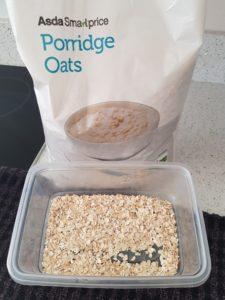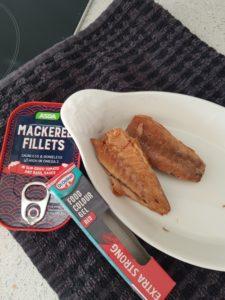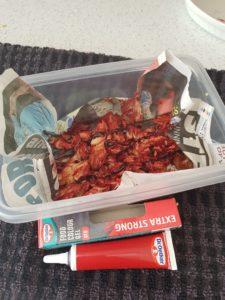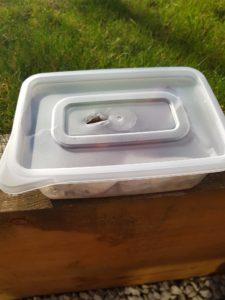How to Make Maggots for Fishing
I was looking on-line for sites, in the UK, that sell fishing baits; such as maggots. Getting to my local fishing shop can be difficult due to the hours that I work and so I typically order my baits on-line and get them delivered a couple of days before I want to use them.
So I’m looking at the prices of maggots and started to think to myself “just how hard and expensive would it be to produce my own maggots?”
I decided to find out and created this post to explain the steps I followed so you can too.
Best done during the mild-weather months, you’ll need:
- Old food container/tin with a hole bored in the lid
- Oats placed in the bottom
- Newspaper on top of the Oats
- Raw meat
Place the container outside in a safe place and wait for small white eggs to appear.
Secure the raw meat in the newspaper and wait for the larvae to hatch.
Ok, sure enough, maggots from your local fishing shop are not going to break the bank. My local fishing shop sells them at about £3 for a pint; prices vary for coloured or scented (flavoured) variations.
But if you’re a regular on the banks and venture out almost every weekend or 1-2 times a week, then a pint won’t go very far and you could soon be looking at between £15-£20 per month.
I can easily understand how it can become, not only cost effective, but also convenient, for some people, to cultivate their own maggots.
Cultivating Maggots for Fishing
Cultivating, or making your own maggots, doesn’t require any special equipment and is very easy to do, much easier than making a worm farm, which I will cover in another post.
Before I list the equipment I use its worth pointing out that an important requirement is the weather. Its practically impossible to cultivate maggots in your garden/home during the winter months.
Maggots hatch from larvae laid on decaying flesh by Blue bottle or Green bottle flies. As I’m sure you’ve noticed, these flies become much more prevalent during the milder or warmer months. Without flies there are no maggots.
What You’ll Need:
- Meat or fish, preferably raw. I tend to keep any left over cuts I have from cooking. You’ll need the equivalent quantity of a couple of chicken breasts, although you can add more later. Mackerel and Chicken both work very well.
- A container with a lid. I used to recommend using a large Tupperware tub, and while this will work perfectly well, I now prefer to use a larger tub such as these from Amazon – Really Useful Storage Box
- Bran or Oats. You could even use sawdust if you have it hand. The purpose is to help dry out the maggots a little so they can’t climb the edges of your container and also help reduce the smell.
- Any old newspaper will do, you’ll need approximately 4-5 sheets.
- A Sieve – Make sure you don’t use the one out of the cooking cupboard, my wife wasn’t impressed the first time I did that. I use these Apollo Gardening Sieves from Amazon. You could get something similar from most fishing shops.
Steps for Cultivating Maggots:
Take your container and bore one or 2 holes in the lid. The holes need to be no larger than 2cm in diameter, just big enough to allow flies in to feed and lay their larvae on the meat.
Sprinkle oats in to the bottom of the container, no more than 1cm deep. The oats will help to soak up any moisture that is produced by both the maggots and the rotting flesh of the meat. Wet maggots have the ability climb and escape through the holes in the container. The oats also help to reduce the rancid smell.
Lay a couple of sheets of newspaper on top of the oats. Once the meat shows signs of larvae we’ll be wrapping the meat in the newspaper so ensure there is enough do so.
Place the meat on to the centre of the news paper and place the lid on the container.
Put the container in a safe place in your garden. Somewhere that wildlife or pets won’t disturb it trying to get at either your rotting meat or the maggot, Birds love them! I’d also recommend placing it somewhere away from your house, the smell it produces can get quite offensive and is certainly not a favourite of my wife’s.
Check the meat daily; you should start to see fly larvae appear on. The larvae appears in clumps of small white tube-like eggs.
A day after the larvae appear, fold up the sides of the newspaper and tie together using an elastic band to seal the meat and larvae in a parcel; return the lid to the container.
Over the next 2-3 days the larvae will hatch and the maggots will feast on the decaying meat. If you like you can add some extra meat, such as left over chicken from one of your meals.
Keep an eye on the contents daily to ensure that the maggots are not climbing the sides of the container and escaping. If they are climbing the sides then add an extra dusting of oats.
After 4-5 days since the presence of the larvae, you should have plenty of nice, juicy maggots that haven eaten most, if not all of the rotten meat.
Empty the contents in to a sieve such as this, to remove the maggots from any remaining newspaper and meat. Be sure to hold a new container, such as a bait box, under the sieve.
Add another sprinkle of oats and your maggots are ready for fishing.
** IMPORTANT – Always take care when handling raw or rotten meat, clean your hands thoroughly **




Add Colour and Flavour (Scent)
Unfortunately coloring your own maggots is not an easy task. I’ve tried the methods you would expect, such as red food coloring; but this soon washes off and you’re left with a white maggot again.
Coloured maggots are produced by being fed meat which has been dyed a certain colour. I’m going to experiment with this method and will update this post when I do.
As for flavouring, or adding scent to maggots? this is a very common practice and you can experiment with a lots of different methods.
Amazon sell liquids which can be added to fishing baits in order to give them and intense aroma in hope of attracting fish.
I’ve had a lot of luck by adding a sprinkling of curry powder to my maggots as soon as they’re added to my bait box, this ensures that the aroma has plenty of time to attach to the maggots before you use them.
Be aware though, your fingers will smell like curry for a couple of days following.
You could also try using a curry paste. A bold red curry paste may even add some colour; try mixing a teaspoon of Tika curry paste in with your maggots and allow them to sit in it for a day before using.
How Long do Maggots Live ?
Maggots will eventually either die or turn in to Castors before they transition in to flies.
The speed at which they either die or turn in to Castors largely depends on how they are kept.
The warmer the environment in which the maggots are kept will speed up their metabolism and conversely, a cooler environment will slow it down.
It is best to keep maggots in a bait box (with air holes) in the fridge, ensure that the lid is secure or you’ll end up with them all over your fridge.
Or, if like me, you have a better half that doesn’t want them in the fridge; I keep them in a bait box sat floating in a bowl of cold water, again, ensure the lid is secured to prevent them escaping.
Fresh maggots can keep for up to 2 weeks if kept in a cold, dark environment with air to breath.

